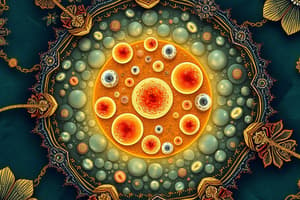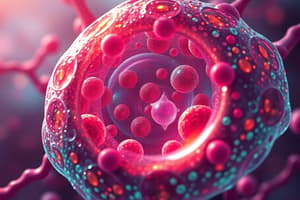Podcast
Questions and Answers
What is the primary function of mitochondria?
What is the primary function of mitochondria?
- Photosynthesis
- Protein synthesis
- Lipid synthesis
- Cellular respiration (correct)
Which organelle is responsible for maintaining homeostasis within a cell?
Which organelle is responsible for maintaining homeostasis within a cell?
- Golgi apparatus
- Endoplasmic reticulum
- Mitochondria (correct)
- Nucleus
What is the main function of the cell membrane?
What is the main function of the cell membrane?
- Cell division
- Protein synthesis
- Energy production
- Regulating passage of molecules (correct)
Which organelle is responsible for lipid synthesis in a cell?
Which organelle is responsible for lipid synthesis in a cell?
Where are small structures called organelles located within a cell?
Where are small structures called organelles located within a cell?
What is the main function of mitochondria in the cell?
What is the main function of mitochondria in the cell?
Which organelle is responsible for protein synthesis in the cell?
Which organelle is responsible for protein synthesis in the cell?
What distinguishes rough endoplasmic reticulum (ER) from smooth ER?
What distinguishes rough endoplasmic reticulum (ER) from smooth ER?
Which organelle is responsible for storing the cell's genetic information?
Which organelle is responsible for storing the cell's genetic information?
Among the organelles mentioned, which one plays a crucial role in secretion and intracellular transport?
Among the organelles mentioned, which one plays a crucial role in secretion and intracellular transport?
Flashcards are hidden until you start studying
Study Notes
Cell and Cell Organelles
Cells are the fundamental units of life, serving as the building blocks for all living organisms. Within cells, there are specialized structures known as "organelles," which perform specific functions to maintain the cell's overall health and proper functioning. This article will delve into the structure and functions of various organelles within cells, focusing on the subtopics of cell structure, cell membrane, mitochondria, endoplasmic reticulum, nucleus, and Golgi apparatus.
Cell Structure
Cells are composed of two main regions: the cytoplasm and the nucleus. The cytoplasm, a fluid matrix, surrounds the nucleus and is bound by the outer membrane of the cell. It contains small structures called organelles, which are responsible for carrying out various functions necessary for the cell's survival and maintenance of homeostasis. Organelles can be classified into two categories: membranous and non-membranous.
Cell Membrane
The cell membrane, also known as the plasma membrane, is a lipid bilayer that surrounds the cell and separates it from its extracellular environment. It is composed of phospholipids, cholesterol, and proteins, which form a selective barrier that controls the passage of molecules in and out of the cell.
Mitochondria
Mitochondria, often referred to as the "powerhouse" of the cell, are oval-shaped, membrane-bound organelles that serve as the primary site of cellular respiration. They generate ATP, the energy currency of the cell, through a process called oxidative phosphorylation. Mitochondria also play a role in storing energy in the form of lipids and are involved in various other cellular processes, such as heat production and calcium signaling.
Endoplasmic Reticulum
The endoplasmic reticulum (ER) is a membrane-bound, tubular network within the cytoplasm of eukaryotic cells. It is involved in protein synthesis, lipid synthesis, and detoxification. The ER is highly dynamic and is divided into two main types: rough ER, which is studded with ribosomes and involved in protein synthesis, and smooth ER, which lacks ribosomes and is involved in lipid synthesis and detoxification.
Nucleus
The nucleus is the largest, double membrane-bound organelle within a eukaryotic cell. It contains all the cell's genetic information in the form of DNA, which is organized into chromosomes. The nucleus controls the activity of the cell, plays a role in cell division, and is responsible for the inheritance of genetic traits.
Golgi Apparatus
The Golgi apparatus is a membrane-bound, sac-like organelle that plays a crucial role in secretion and intracellular transport. It modifies, sorts, and packages proteins and lipids synthesized in the endoplasmic reticulum and nucleus, preparing them for transport to their final destinations within the cell or for secretion outside the cell.
In conclusion, cells are complex structures composed of various organelles that work together to maintain the cell's health and perform its essential functions. Understanding the structure and functions of these organelles is vital for understanding the fundamental biology of living organisms.
Studying That Suits You
Use AI to generate personalized quizzes and flashcards to suit your learning preferences.




